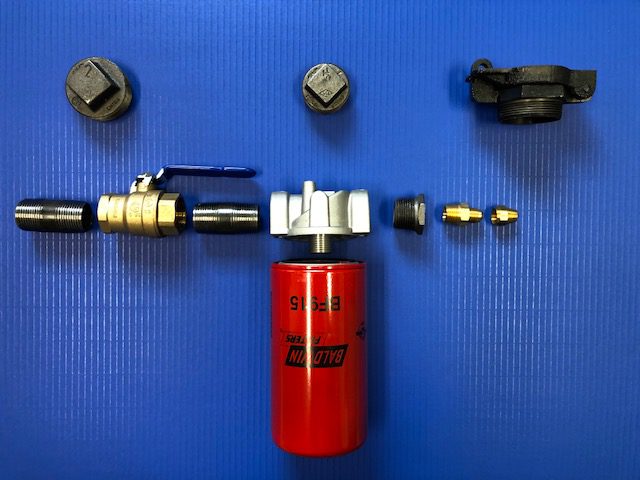Tank Location
Make sure the site and stand will provide adequate height for gravity fuel pressure. For example, Toyostove recommends that the bottom of the tank be at least 16” above the floor level on which the stove is set. The top of the tank should be less than 8’ above that same floor level. Non-gravity-fed heaters do not require specific heights and should be installed only high enough to avoid contact with the ground or excessive vegetation. Avoid setting tanks in the dripline of an eave of the building to prevent rainwater from entering the tank. If the fill pipe must be under the eave, cover it with a can to prevent water from siphoning from accumulated snow on the tank.
The second story, Toyostoves, presents additional challenges. A stand and tank tall enough to provide gravity flow to a second story is an added risk of tipping and injury to delivery personnel. Other options include a lift pump to the upper stove or installing fans to assist the natural convection of heat from the lower level.
Kennels, storage and fuel tanks don’t go well together. Snow-covered objects are a hazard as well. Ladders are appreciated if they are solid and well maintained. 80’ is the longest recommended distance from your tank to where the truck can be parked.
Tank Support
Ensure that the tank site is solid enough to support a full fuel tank (2000-3000 lbs.). Compact loose soils or replace them with compacted gravel. Support should be augmented by placing treated wood or concrete under the stand supports to distribute the weight. A severe earthquake can tip a tank over. Strapping the tank to its stand and a building can help prevent this. Stands should be made of non-combustible materials. If your stand is made of wood, it should be bolted together and cross-braced. Nails and screws can loosen as wood ages.
Fuel Lines
Avoid installing fuel lines between tanks and buildings across large enough gaps for an animal or person to pass through. Avoid vertical spirals and unnecessary ups and downs in fuel lines to prevent potential air bubbles from collecting at high points. Fuel lines across a yard or driveway should be inside a protective conduit or tube made of fuel resistant material to contain possible leaks and buried adequately to prevent damage.

Fittings
When assembling and installing the tank fittings, use both Teflon tape and paste. Wrap Teflon tape around male pipe threads in a clockwise direction, then coat lightly with paste. Fittings should be tight, but it is possible to split a brass valve or aluminum filter by excessive tightening. Be sure to install the ball valve with the handle pointing away from the tank when open.
Flare Fittings
Connect fuel line using only “flare” type brass fittings. Do Not use compression fittings; they will ultimately leak. Remember to put the flare nut on the line first. Practice using the flare tool before you make your final flare. The flare should slip inside the nut but fill it. Check to ensure there are no cracks in the flared copper.
Tighten the flare nut in stages, making each time a bit tighter. This will “burnish” the copper flare to conform to the brass fitting. The nut should tighten with a sudden stop when done.
Tightening a flare nut all at once can split it, causing a leak.

Tank Monitoring System
Our professionally installed tank monitoring service gives you peace of mind that you will never run-out. See your propane tank level anytime, anywhere through our smart monitor and free mobile phone app!
Why Tank Monitoring?
With tank monitoring, you will be able to:
- Track your tank’s current level from your phone from anywhere
- Save money by better managing your monthly energy consumption
- Eliminate the guesswork of when you need a fill-up with low tank alerts
Most importantly, we will also be monitoring your tank level to ensure efficient deliveries, so you don’t run-out! It’s a great value add to customers with generators, second homes or primary residences, as well as commercial and agricultural customers!
How Does It Work?
- We will professionally install a monitor on your tank
- Once installed, download and setup the free Tank Utility app on your phone
- From the app, receive real-time alerts when your tank is low and monitor your monthly fuel consumption anytime from anywhere
- We will also monitor your tank level to help prevent run-outs!
Watch our video to learn more about tank monitoring services.
How Do I Sign Up?
For more information, sign up here or call us at 907-235-1393! A Homerun Oil team member will be in touch right away!
Technical Fuel Questions
Important Information About Petroleum
Petroleum-based fuels have undergone numerous changes in the past 100 years. All of the Petrochemicals and fuel products available today are derived from petroleum soup we call crude oil. Crude oil is just that, a soup of various hydrocarbon molecules of various shapes and sizes, each having unique properties and characteristics.
Industry uses processes called by names like "distilling" and "cracking" and "reforming" to separate and enhance the products into usable groups and forms.
Crude oil contains many products, from asphalt to lubricating oils to fuels to other products' chemical feedstock. The most familiar products for most people are fuels and lubricants.
At Homerun Oil Co., our main focus is providing our customers with fuel products to keep you warm and get you where you need to go. Most people are not concerned about the what and how of petroleum. They want the result it gives them. But when people do ask, they usually ask, "what is the difference between………" So just for fun, here are some words you've heard but may be wondering.
